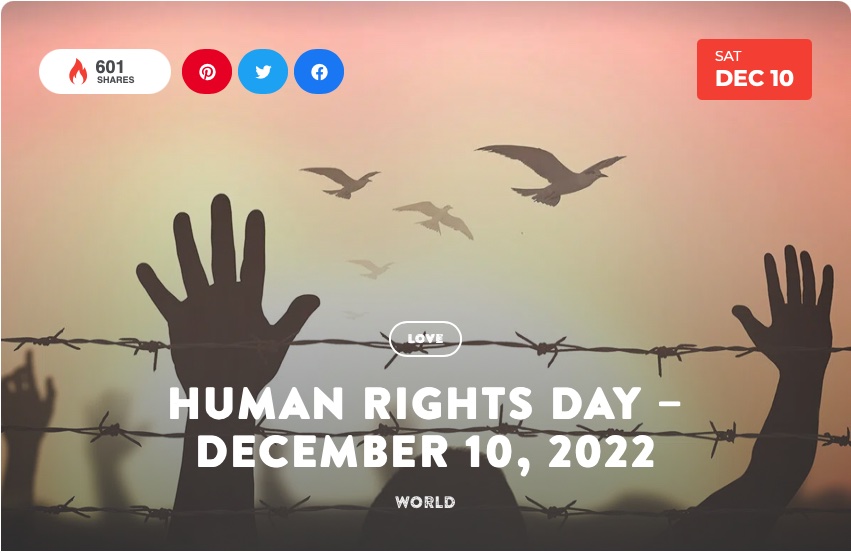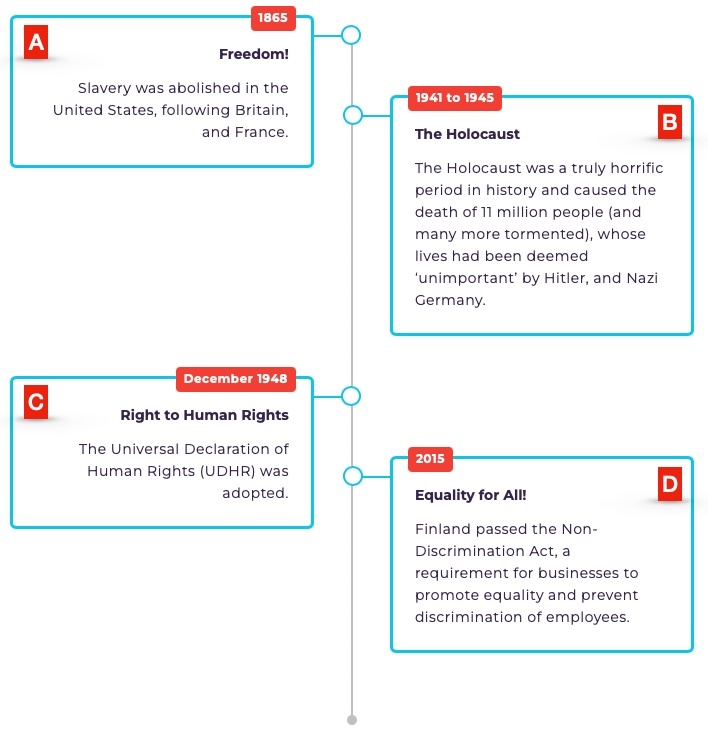
Human Rights Day
Human Rights Day on December 10 remembers the day the General Assembly of the UN adopted and proclaimed the Universal Declaration of Human Rights in 1948. It is the most translated document around the world and is available in over 500 languages. It has inspired countries and people alike to start treating every person with the right to life, liberty, property, and the pursuit of happiness. On Human Rights Day we acknowledge the importance of this document and the importance of human rights.

HISTORY OF HUMAN RIGHTS DAY
Human Rights Day is the anniversary of the day in 1948 when the United Nations General Assembly adopted the Universal Declaration of Human Rights. The day’s popularity is perhaps best demonstrated by the commemorative stamp that was issued by the United Nations Postal Administration in 1952, which received over 200,000 advanced orders.
The aim of the Declaration of Human Rights is to establish a common standard of living for all people across the planet that everyone is entitled to, and to in turn encourage all UN member states to strive towards the said standard of living for the people in their nation.
Although the rights are seen as more declarative than legally binding, they are commonly acknowledged to have had an impact on how human rights are perceived and to be a force for good.
Nowadays a different theme is selected for Human Rights Day each year. In 2014 the theme was “Every Day is Human Rights Day” and in 2016 it was “Stand up for someone’s rights today.” We should remember our human rights every day, but on December 10 we should remember them just a little bit more and embrace everyone around us as equals.
HUMAN RIGHTS DAY TIMELINE

![]() Freedom – Slavery was abolished in the United States, following Britain and France
Freedom – Slavery was abolished in the United States, following Britain and France
![]() The Holocaust – The Holocaust was truly a horrific period in history and caused the death of 11 million people (and many more tormented), whose lives had been deemed “unimportant” by Hitler, and Nazi Germany.
The Holocaust – The Holocaust was truly a horrific period in history and caused the death of 11 million people (and many more tormented), whose lives had been deemed “unimportant” by Hitler, and Nazi Germany.
![]() Right to Human Rights – The Universal Declaration of Human Rights (UDHR) was adopted.
Right to Human Rights – The Universal Declaration of Human Rights (UDHR) was adopted.
Below you can see the UN Members that have adopted the Human Rights and promised to follow Human Rights. Therefore, we can demand the UN members that they furthermore develops the implementation of Human Rights in their nations.
![]() Equality for all – Finland passed the Non-Discrimination Act, a requirement for businesses to promote equality and prevent discrimination of emplyees.
Equality for all – Finland passed the Non-Discrimination Act, a requirement for businesses to promote equality and prevent discrimination of emplyees.
HUMAN RIGHTS DAY FAQS
Why is Human Rights Day celebrated?
This day was chosen to honor the founding of the Universal Declaration of Human Rights on December 10, 1948.
When is Human Rights Day?
December 10
What is the theme of Human Rights Day 2020?
The theme has not been decided yet. (Tip: Article 1; Human Rights)
HOW TO OBSERVE HUMAN RIGHTS DAY
- Donate to your favorite Human Rights charity.Is there a charity championing human rights that really strikes a chord with you? Maybe today is the day to remember them and make a donation.
- Attend a human rights event.There are political conferences, meetings, exhibitions, cultural events, and debates held on this day. Why not attend one and be part of the community?
- Show your support for human rights.Show your support for human rights by posting online or getting involved in online discussions.
5 FACTS ABOUT HUMAN RIGHTS
- Leading by ExampleKing Cyrus II of Persia, also known as King Cyrus the Great, the founder of the first Persian Empire, freed slaves, established racial equality, and gave the right to religious choice.
- Know your rightsEveryone has a right to leisure and holiday, with pay thanks to Article 24 of the Universal Declaration of Human Rights.
- Think of the childrenThere are approximately 250,000 child soldiers in the world today spread across 20 countries. About 40% of these are girls who are often used as sex slaves and taken as “wives” by male fighters.
- A Long BattleThe women’s suffrage movement lasted 17 years. To gain the right to vote, women protested (Led by Susan B. Anthony and others), and governments slowly allowed it, from 1894 and 1911, before it became federally regulated in 1902.
- A Global ProblemIt is estimated that 12 million girls are married in childhood (under the age of 16-18) each year, according to the latest prevalence and population figures collected by UNICEF.
WHY HUMAN RIGHTS DAY IS IMPORTANT
- People deserve to be treated fairly, with dignity, and respect.We are all born equal and should be treated as such. Every person deserves a set of rights by which they can live their life as they choose, and without being oppressed, suppressed or owned by someone else.
- It reminds us how far we have come.Whilst there is still definitely a long way to go, we should take a moment to acknowledge that progress is being made, and the world is a better and fairer place for more people than it was a few hundred years ago. Let’s acknowledge that and then crack on with the improvements that still need to be made.
- It promotes unityThe Declaration of Human Rights was agreed upon by 48 member states when it was first created. That’s 48 countries sharing a common belief that life should be and can be better for everyone.
HUMAN RIGHTS DAY DATES

HUMAN RIGHTS DAY RELATED HOLIDAYS

International Day of Tolerance on November 16
International Day of Tolerance on November 16 is a great opportunity for you to think back and recall the last time you had a different perspective than one of your friends? When’s the last time you’ve had to learn something about someone else’s culture? We’re betting it wasn’t that long ago. Look and learn the date that celebrates open-mindedness and listening.
The International Day of Peace (or World Peace Day) celebrated annually on September 21
The International Day of Peace (or World Peace Day) celebrated annually on September 21 is devoted to strengthening the ideals of peace, both within and among all nations and peoples. At a time when war and violence often monopolize our news cycles, the International Day of Peace is an inspiring reminder of what we can create together. Peace. Let’s give it a chance!
The Peace Festival in Augsburg on August 8
The Peace Festival in Augsburg on August 8 has been Germany’s only municipal public holiday since 1950. Also known as the “Augsburg High Peace Festival,” this annual festival is only celebrated in Augsburg, a city with Roman Catholic roots that once forbid its citizens the right to practice the Christian faith as Protestants. The bitter divide between Roman Catholics and Protestants has a long ignoble history, which makes the festival even more significant in our world where passionate religious beliefs still lead to wars not just between nations, but within families.
SECTION II – The History of The Universal Declaration of Human Rights
The Universal Declaration of Human Rights (UDHR) is an international document adopted by the United Nations General Assembly that enshrines the rights and freedoms of all human beings. Drafted by a UN committee chaired by Eleanor Roosevelt, it was accepted by the General Assembly as Resolution 217 during its third session on 10 December 1948 at the Palais de Chaillot in Paris, France.[1] Of the 58 members of the United Nations at the time, 48 voted in favour, none against, eight abstained, and two did not vote.[2]
A foundational text in the history of human and civil rights, the Declaration consists of 30 articles detailing an individual’s “basic rights and fundamental freedoms” and affirming their universal character as inherent, inalienable, and applicable to all human beings.[1] Adopted as a “common standard of achievement for all peoples and all nations”, the UDHR commits nations to recognize all humans as being “born free and equal in dignity and rights” regardless of “nationality, place of residence, gender, national or ethnic origin, colour, religion, language, or any other status”.[3] The Declaration is considered a “milestone document” for its “universalist language“, which makes no reference to a particular culture, political system, or religion.[4][5] It directly inspired the development of international human rights law, and was the first step in the formulation of the International Bill of Human Rights, which was completed in 1966 and came into force in 1976.
Although not legally binding, the contents of the UDHR have been elaborated and incorporated into subsequent international treaties, regional human rights instruments, and national constitutions and legal codes.[6][7][8]
All 193 member states of the United Nations have ratified at least one of the nine binding treaties influenced by the Declaration, with the vast majority ratifying four or more.[1] While there is a wide consensus that the declaration itself is non-binding and not part of customary international law, there is also a consensus that many of its provisions are binding and have passed into customary international law,[9][10] although courts in some nations have been more restrictive on its legal effect.[11][12] Nevertheless, the UDHR has influenced legal, political, and social developments on both the global and national levels, with its significance partly evidenced by its 530 translations, the most of any document in history.[13]
- 1Structure and content
- 2History
- 3Impact
- 4Reaction
- 5See also
- 6Notes
- 7References
- 8Further reading
- 9External links
IIa) Structure & content
The underlying structure of the Universal Declaration was influenced by the Code Napoléon, including a preamble and introductory general principles.[14] Its final structure took form in the second draft prepared by French jurist René Cassin, who worked on the initial draft prepared by Canadian legal scholar John Peters Humphrey.
The Declaration consists of the following:
- The preamble sets out the historical and social causes that led to the necessity of drafting the Declaration.
- Articles 1–2 establish the basic concepts of dignity, liberty, and equality.
- Articles 3–5 establish other individual rights, such as the right to life and the prohibition of slavery and torture.
- Articles 6–11 refer to the fundamental legality of human rights with specific remedies cited for their defence when violated.
- Articles 12–17 set forth the rights of the individual towards the community, including freedom of movement and residence within each state, the right of property and the right to a nationality.
- Articles 18–21 sanction the so-called “constitutional liberties” and spiritual, public, and political freedoms, such as freedom of thought, opinion, expression, religion and conscience, word, peaceful association of the individual, and receiving and imparting information and ideas through any media.
- Articles 22–27 sanction an individual’s economic, social and cultural rights, including healthcare. It upholds an expansive right to an adequate standard of living, and makes special mention of care given to those in motherhood or childhood.
- Articles 28–30 establish the general means of exercising these rights, the areas in which the rights of the individual cannot be applied, the duty of the individual to society, and the prohibition of the use of rights in contravention of the purposes of the United Nations Organization.[15]
Cassin compared the Declaration to the portico of a Greek temple, with a foundation, steps, four columns, and a pediment.[16] Articles 1 and 2—with their principles of dignity, liberty, equality and brotherhood—served as the foundation blocks. The seven paragraphs of the preamble, setting out the reasons for the Declaration, represent the steps leading up to the temple. The main body of the Declaration forms the four columns. The first column (articles 3–11) constitutes rights of the individual, such as the right to life and the prohibition of slavery. The second column (articles 12–17) constitutes the rights of the individual in civil and political society. The third column (articles 18–21) is concerned with spiritual, public, and political freedoms, such as freedom of religion and freedom of association. The fourth column (articles 22–27) sets out social, economic, and cultural rights. Finally, the last three articles provide the pediment which binds the structure together, as they emphasize the mutual duties of every individual to one another and to society.[16]
Preamble
Whereas recognition of the inherent dignity and of the equal and inalienable rights of all members of the human family is the foundation of freedom, justice and peace in the world,
Whereas disregard and contempt for human rights have resulted in barbarous acts which have outraged the conscience of mankind, and the advent of a world in which human beings shall enjoy freedom of speech and belief and freedom from fear and want has been proclaimed as the highest aspiration of the common people,
Whereas it is essential, if man is not to be compelled to have recourse, as a last resort, to rebellion against tyranny and oppression, that human rights should be protected by the rule of law,
Whereas it is essential to promote the development of friendly relations between nations,
Whereas the peoples of the United Nations have in the Charter reaffirmed their faith in fundamental human rights, in the dignity and worth of the human person and in the equal rights of men and women and have determined to promote social progress and better standards of life in larger freedom,
Whereas Member States have pledged themselves to achieve, in co-operation with the United Nations, the promotion of universal respect for and observance of human rights and fundamental freedoms,
Whereas a common understanding of these rights and freedoms is of the greatest importance for the full realization of this pledge,
Now, therefore,
The General Assembly,
Proclaims this Universal Declaration of Human Rights as a common standard of achievement for all peoples and all nations, to the end that every individual and every organ of society, keeping this Declaration constantly in mind, shall strive by teaching and education to promote respect for these rights and freedoms and by progressive measures, national and international, to secure their universal and effective recognition and observance, both among the peoples of Member States themselves and among the peoples of territories under their jurisdiction.